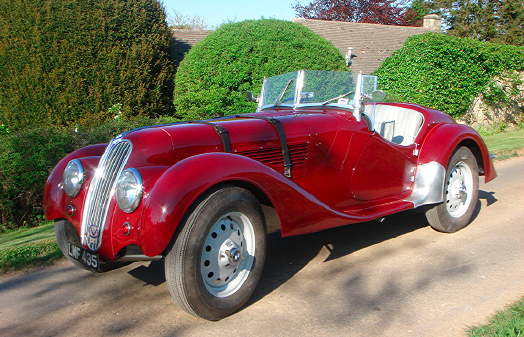Aero engine and motorcycle maker BMW became a car manufacturer when it bought the Dixi-Werke factory in 1928. Dixi built Austin Sevens under licence as the Dixi 3/15PS DA-1, and bigger cars followed using a new backbone chassis with independent suspension at both ends by transverse leaf spring and swing axles. Power came from a 785cc in-line four engine which had its origins in the old 747cc Austin unit, though the side valves had been replaced by overhead valves operated by pushrods and rockers.
When more power was needed, a six-cylinder version was built, and by 1936 this engine had reached its practical size limit at 1971cc, developing around 55bhp in road-going tune. To further increase power development engineer Rudolf Schleicher designed an efficient hemispherical combustion chamber with opposed valves and a central spark plug. Instead of the complexity and cost of twin overhead camshafts, he retained the existing single camshaft and added horizontal ‘cross pushrods’ over the top of the engine to operate the exhaust valves. Fed by three Solex downdraught carbs, Schleicher’s new engine developed 80bhp in road-going trim and up to 135bhp in race tune.
The new engine went into a sports car, the BMW 328, with a twin-tube chassis, and independent front suspension. The light alloy body had the front wings, bonnet and headlamps blended together, giving the 328 a modern, curvaceous look and excellent aerodynamics. It made its public debut at the Eifelrennen sports car race at the Nurburgring in June 1936, finishing first and third in its class – the first of numerous sports car racing victories for the 328. Serious production began the following year, but the 328 was only ever a niche product: just 464 were built between 1937 and 1939, about 50 of which were right-hand drive cars sold by AFN as the Frazer Nash-BMW at a cost of £695. Today, thanks to the 328's colossal reputation and rarity, a good example will be worth around £400,000.
A driver used to modern cars would feel right at home driving the 328: it’s much easier to drive than many contemporary sports cars. The three-spoke steering wheel is about the same size as on a modern car and controls unassisted steering which is light and responsive. The pedals are close together, but well-placed for heel-and-toe footwork and pedal pressures are low.
The 328’s six-cylinder motor spins freely with a crisp, energetic sound and produces enough performance to keep up with modern traffic. Its real advantage over other 70-year-old sports cars comes in the corners: the stiff tubular chassis and supple suspension gives it a sure-footed feel even when the road surface takes a turn for the worse.
For a pre-war machine the BMW 328 is amazingly capable. It’s no wonder that it was such a success in racing – and such a valuable car today.
www.bmwhistoricmotorclub.co.uk
1937-39 Frazer Nash-BMW 328
Engine 1971cc, in-line six cylinder, ohv, triple Solex downdraught carburettors
Power and torque 80bhp @ 5000rpm; 96lb ft
Transmission Four-speed manual, rear-wheel drive
Brakes Hydraulic; drums front and rear
Suspension Front: wishbone and transverse leaf spring with integral single-acting dampers. Rear: live axle with leaf springs and lever-arm dampers
Steering Rack and pinion
Weight 830kg (1830lb)
Performance Top speed: 95mph. 0-60mph: 10.5sec
Fuel consumption 20mpg
Cost new £695 in UK
Photo: BMW Historic Motor Club
